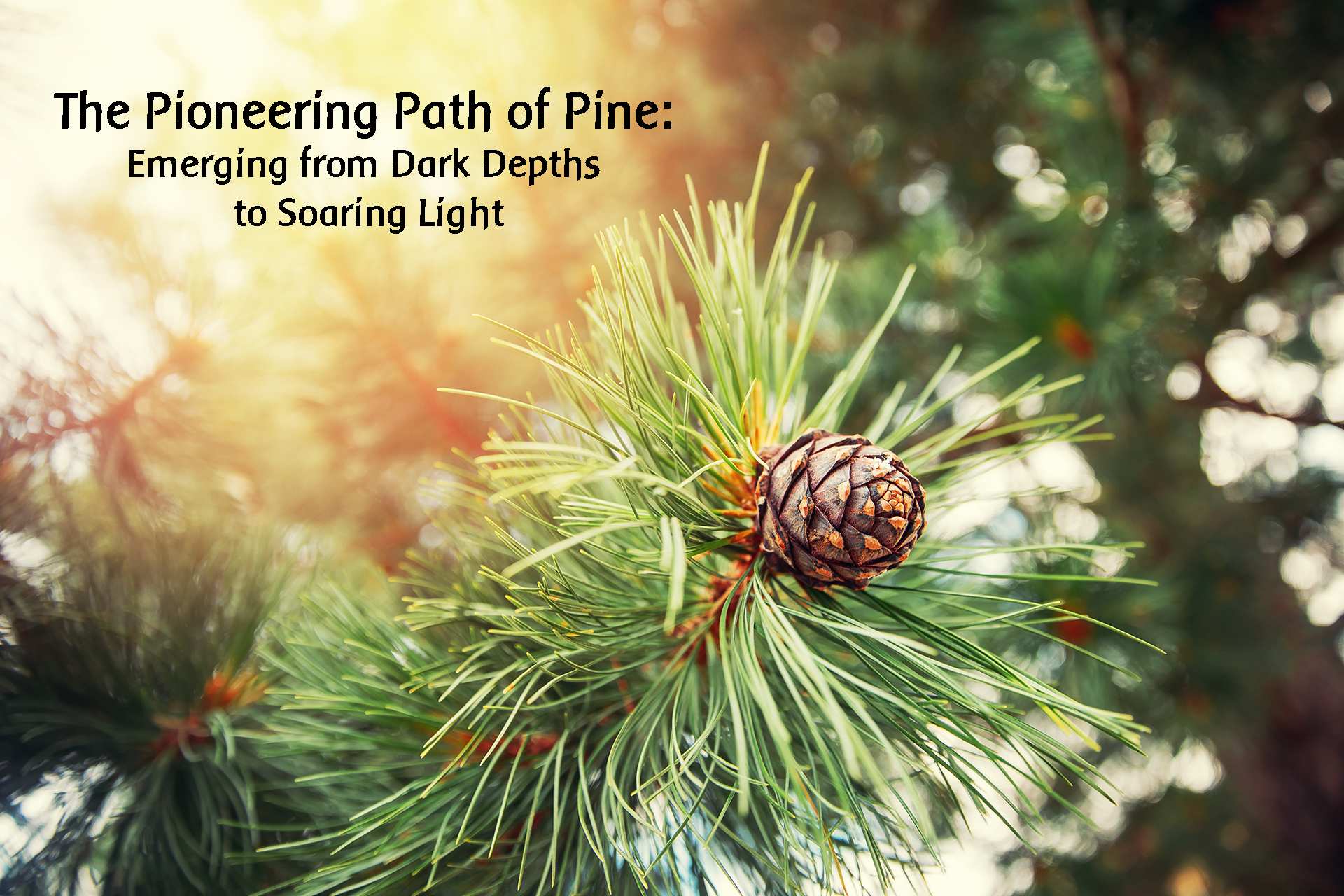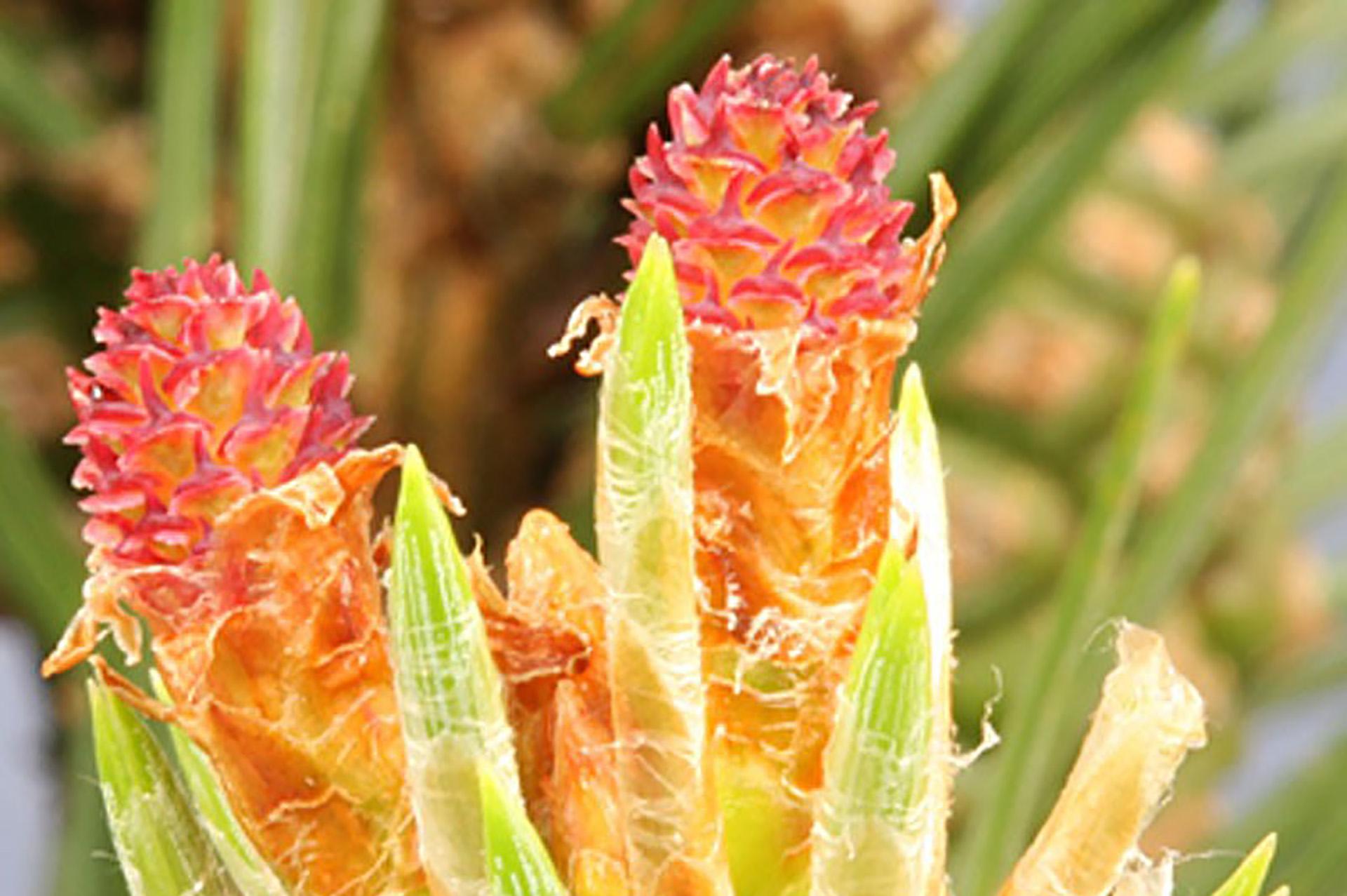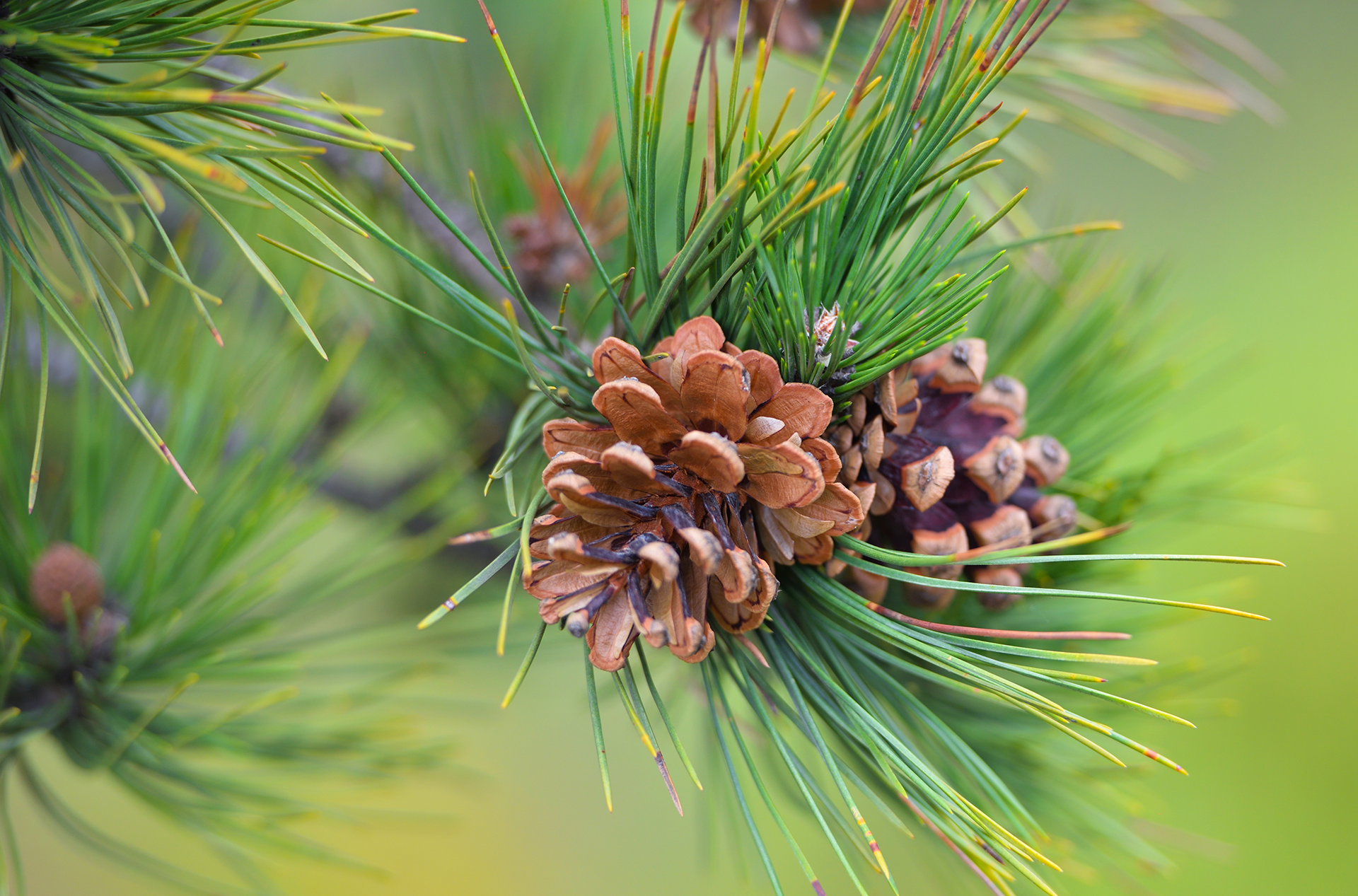
By Patricia Kaminski

In the winter months the conifer “evergreens” bestow such inspiring gifts of Nature’s green life force, at a time when most other plants have gone dormant or died away. Among the conifers, the Pine Tree in particular beckons to us with its soaring stature and glistening shimmer of light in its needles. The entire gesture of Pine is one of skyward vertical lines of ascent – a vivid counterpoint to the downward, darkened and dormant forces of winter. The Pine Tree easily sheds it older branches as it rises to sublime heights. Even the needle leaves of the Pine Tree are a reflection of its whole form; their linear extensions richly saturated in silica, the most light-bearing of all minerals.
The Conifers – Evolving the First Flowering Activity Within Plant Life
The conifers play a unique role in the evolution of plant life on earth. They were the first plants to learn how to flower, developing beyond algae, lichens, mosses, ferns, equisetum, and other vegetative or spore producing plants. To accomplish this, they forged a path over eons of time, through the dark, dense and moist layers that enveloped the primal earth, yearning toward cosmic light-bearing forces that engender flowering. As such, the pine cone is a remarkable kind of primitive flower, belonging to the class of gymnosperms which do not yet enclose their seeds in an ovary. Rather they are open to the air and light, developing their reproductive forces slowly and deliberately in three stages over approximately three years. The pollen-bearing cones or catkins in the lower part of the tree produce waves of pollen and then drop away from the tree. Meanwhile, the pollen wafts its way on air currents, meeting vibrant red cones in the upper branches of the Pine tree. By the second year, these still developing cones are small and green. Finally in the third year these cones mature into brown wooden structures, with seeds attached to their scales.

|

|
|
|
|
The Saturn Condition – Warmth Enveloped in Germinal Darkness
Ancient herbal lore assigns the conifer trees to the influence of the planet Saturn. We can understand this connection by realizing that the archetypal spiritual realm of Saturn (beyond the physical planet we see today) is esoterically associated with the beginning of Earth Evolution, what can be considered the primal beginnings of Creation. For example this Native American Ojibwe poem, To The Pine Tree, by Jane Johnston Schoolcraft (1800–1842), conveys a deep spiritual recognition of the Pine Tree as “forever green” emerging from the homeland of the Father-Creator, “The one I see, the Pine Tree, I return back, to my homeland. The Pine, the Pine my father!…Forever you are green…” (See sidebar for the complete poem.)
The great western initiate, Rudolf Steiner describes this primordial Saturn condition as the profound beginning of Earth Evolution, emerging from the Father Ground of Creation. Within this immense Spiritual Presence was a powerful creative darkness containing inner warmth, where the seed-like forces of physical life could germinate. This truth is expressed in the First Chapter of Genesis, “And the earth was without form, and void; and darkness was upon the face of the deep.”

As a whole, the conifers carry a primordial memory of this Saturn condition. Out of a kind of brooding, germinally creative communion with darkness, they were able – over eons of time – to cultivate a vital living warmth that gradually ascended into the realm of light, attaining the first rudiments of plant flowering. From these stunning initiatory impulses, the stupendous diversity of the plant life we know today, could then develop. This “new beginning” in plant evolution is wonderfully conveyed by Loren Eiseley in “How Flowers Changed the World.”
Native American Ojibwe poem:
To The Pine Tree
Zhingwaak! Zhingwaak! Ingii-ikid, –
Pine! Pine! I said,
Weshki waabamag zhingwaak –
The one I see, the Pine Tree
Dagoshinaan neyab, endanakiiyaan. –
I return back, to my homeland.
Zhingwaak, zhingwaak nos sa! –
The Pine, the Pine my father!
Azhigwa gidatisaanan –
Already you are colored
Gaagige wezhaawashkozid. –
Forever you are green
Mii sa naa azhigwa dagoshinaang –
So we already have arrived
Bizindamig ikeyaamban –
Listen in that direction
Geget sa, niminwendam –
Certainly I am happy
Miinwaa, waabandamaan –
And I see
Gii-ayaad awiiya waabandamaan niin –
He was there I saw it myself
Zhingwaak, zhingwaak nos sa! –
The Pine, the Pine my father!
Azhigwa gidatisaanan. –
Already you are colored.
Gaawiin gego, gaa-waabanda’iyan –
Nothing, you did show me
Dibishkoo, ezhi-naagwasiinoon –
Like that, the way it looks
Zhingwaak wezhaawashkozid –
Pine, he is green.
Wiin eta gwanaajiwi wi –
He is beautiful
Gaagige wezhaawashkozid. –
Forever he is the Green One.
Jane Johnston Schoolcraft
A Norton Anthology of Native Nations Poetry
Pine Essential Oil:
Warming, Grounding Qualities that Stimulate Respiration and Circulation

Holding this archetypal picture of Saturn, we can appreciate the special importance of the Pine Tree emerging from the penumbral depths toward its towering presence in the light. In the Pine essential oil extracted from the needle leaves of the Pine, we can particularly note the remarkable healing qualities of warmth opening to air and light. Pine Essential Oil is especially appreciated for its pungent, yet uplifting and cleansing aroma. It has an ability to clear the respiratory tract of phlegm, acting as an expectorant and decongestant to promote easier breathing and soothing symptoms of colds, coughs, sinusitis, and asthma. When used for massage and baths, the warmth of Pine essential oil penetrates into muscles and joints afflicted with arthritis, rheumatism and similar cold, contracted conditions, to stimulate and enhance circulation.
One of the key chemical structures in Pine essential oil, is α-pinene; a kind of mother substance which is found in numerous other plants with later evolutionary histories. The grounding, calming, and pain-relieving qualities of a-pinene are a consistent healing theme in these other essential oils. We can say that the Pinaceae family were the “pine-eers” who first “broke ground” to capture these warming elements of earth ascending into light, and then communicated these chemical structures to many other forms of plant life.
Pine Flower Essence: Transforming Brooding Melancholia
If we hold this imaginative picture of the Pine Tree and its evolutionary path of becoming, we can gain a deeper insight in Dr. Bach’s indications for Pinus sylvestris “… those who blame themselves and are never content with their efforts or results. They are hard-working and suffer much from the faults they attach to themselves.” Here we have the Saturn archetype of a kind of dark, brooding melancholic disposition. Even the English language has incorporated this essential quality in the verb, to pine, meaning to yearn and long for what is past or no longer attainable.
Yet, the healing polarity of the melancholic longing is also contained in the Pine Tree. For it has learned to live with this darkness, finding within it transformative impulses for a future ascent into light. As the Pine Tree has learned so wonderfully to move beyond its past, —literally dropping its lower branches as it strives upward, so also this is the great lesson of the Pine personality, who becomes too burdened with its current feelings of “weight” or failure, and cannot move positively forward.

One of the key insights into the Pine Personality, is not only the outer presentation of pessimism, but a kind of interior coldness and consequent stasis. This coldness may present itself as a contracted or socially aloof condition. Loving warmth is often a quality that such a personality cannot easily receive from others or feel within oneself. In its healing process, the Pine flower essence digs deep into the memory – for instance a childhood with a stern upbringing, a prevailing mood of doom and gloom in the family constellation, or powerful past memories that shroud the soul from its earliest moments of incarnation.
This soul condition may also have penetrated into the body itself, resulting in various “cold” conditions, such as poor circulation. In fact, we need to recognize that external conditions that present as “inflammatory” such as arthritis or rheumatism, are better understood as a misdirected outer fire that attempts to compensate for the core inner warmth often lacking in the Pine constitution. For this reason, it can be very healing in many cases to use the Pine essential oil in tandem with the Pine Flower essence in order to address both the body and soul components fully.
Archetypal Role of Pine Flower Essence: A Man Finds New Purpose and Self-Worth, Overcoming Addiction and Self-Defeating Patterns of Failure
A practitioner recently submitted to the FES Certification Program, a detailed case of a man in his thirties, featuring Pine flower essence as the major constellating essence used in his successful therapy over the course of approximately one year.
At the onset of therapy, this man reported: “I am an adopted child along with an adopted sister who was the golden “perfect” child. My mom and dad were strict with very high expectations and I never felt that I met them. I was always told by my parents that I never reached my potential. As a child, I had chronic asthma and allergies. My teenage years were turbulent and rebellious. I often acted out my frustration of not feeling loved or approved, not feeling like I belonged… I have spent most of my life feeling abandoned, alone, cursed, evil, ashamed and worthless. I have struggled to even be capable of positive inner dialogue and self-talk. I would like to eliminate these negative beliefs and thoughts about myself and cultivate healthy positive beliefs about myself…”
A prominent theme in this man’s life was addiction to various substances, including tobacco, alcohol and marijuana. Attempts to curb these addictions were not successful, resulting in even greater sense of letdown and defeat. He also noted that throughout many jobs and relationships “I have felt like a failure …” He expressed his primary goals for flower essence therapy as that of seeking, "….Self-acceptance, self-worth, self-confidence, self-discipline…….I want to be more giving in all personal relationships. "

During the course of therapy, this man achieved long-term sobriety for the first time in his life. The most pronounced shift was his increased interest and commitment in ‘being with himself’, and practicing positive vulnerability. He reported an increased ability to practice acceptance and re-identification, with greater harmony and honesty in his social relationships. The client further expressed that he felt “.. more objective and compassionate when I feel any guilt, self-blame, or excessive self-criticism . I now understand their source as inherited patterns and limiting beliefs. I feel much less susceptible to those emotional states than I did when therapy started. When they do arise, instead of allowing these feelings and beliefs to paralyze me, I allow them to move through me.”
The practitioner summarized the healing role of Pine: “I feel Pine was the key archetypal remedy for this client. At the start of therapy, his mental landscape and self-image was very bleak and caustic … his overall demeanor was extremely critical and despairing. Without allowing himself the dignity of positive encouragement and the natural grace period of trial and error, it has been very difficult for him to learn, grow, move beyond the past, and express himself freely.
Therefore, he would generally expect some degree of failure, disappointment, and hardship. The Pine flower essence ‘instructed’ this client in a deep process of forgiveness and self-forgiveness. The over-paralysis generated by his belief in his ‘flawed self-worth’ began to shift as a result. In a considerably short period of time, he was able to transcend many layers of self-condemnation, behavioral imbalances, and integrate a practice of self-forgiveness into his life. I don’t think I could have convinced him that he had the choice to move forward solely through my counseling and encouragement. I truly noted the powerful role of this flower essence.”
Key Distinctions with Other Flower Essences
 Buttercup– Both Pine and Buttercup address conditions of crippling self-esteem. The Buttercup type generally feels insignificant due to social status, one’s job, or role in family and community. Such a person does not feel worthy of praise or attention. On the other hand Pine is acutely aware of failures, with a sense of self-blame and defeat, that limits a forward, evolving progression in life.
Buttercup– Both Pine and Buttercup address conditions of crippling self-esteem. The Buttercup type generally feels insignificant due to social status, one’s job, or role in family and community. Such a person does not feel worthy of praise or attention. On the other hand Pine is acutely aware of failures, with a sense of self-blame and defeat, that limits a forward, evolving progression in life.

Gentian – Pine and Gentian share feelings of discouragement. In the case of Gentian, there is a genuine external misfortune, defeat or other set-back that feels so overwhelming, one feels paralyzed. In the case of Pine, any failure is exaggerated, and becomes a source of self-blame, regret or melancholic pessimism. The Gentian type experiences genuine hardship with the need for responsive resilience, while the Pine limits the future by being too hard on oneself.
 Honeysuckle – Both Pine and Honeysuckle share an immersion in the past, which weighs down future potential. However, in the Honeysuckle personality there is a more pleasant escape into nostalgic memories, resulting in a kind of dreamy disconnection from current reality. On the other hand the Pine personality dwells in a much harsher judgement of its past and a type of masochistic preoccupation with faults and failures.
Honeysuckle – Both Pine and Honeysuckle share an immersion in the past, which weighs down future potential. However, in the Honeysuckle personality there is a more pleasant escape into nostalgic memories, resulting in a kind of dreamy disconnection from current reality. On the other hand the Pine personality dwells in a much harsher judgement of its past and a type of masochistic preoccupation with faults and failures.

Mullein – While the Pine personality burdens itself with overly critical judgement and excessive self-blame, the Mullein type needs to bring a rightful moral assessment of its actions. In particular the Mullein lacks a feeling of self-responsibility and honest ownership of actions that have been hurtful or harmful to others, or generally lacking in honesty.

Pink Monkeyflower – Both Pine and Pink Monkeyflower address feeling of guilt and unworthiness. However, the Pink Monkeyflower has a deeply internalized sense of shame that typically stems from much more traumatic events – such as emotional or sexual abuse, social discrimination or other limiting social identities. In the case of Pine, the focus is much more on personal failures that are exaggerated in one’s mental outlook, so that one loses the confidence to continue to evolve and grow, despite mistakes.
References
An Outline OF Esoteric Science, Rudolf Steiner, Translated by C.E Creeger; (Written 1910, GA 13); ISBN 9780880104098How Flowers Changed the World, Essay in The Immense Journey: An Imaginative Naturalist Explores the Mysteries of Man and Nature by Loren Eiseley , 1959 • ISBN-10 : 0394701577 • ISBN-13 : 978-0394701578
Julian Barnard, Bach Flower Learning Programme, https://www.bachflowerlearning.com/the-language-of-plants/pine/
The Collected Writings of Edward Bach, edited by Julian Barnard, Flower Remedy Programme, Hereford, UK, new and revised edition 2007 • ISBN-10 0-9506610-6-6 • ISBN13 9789-0-9506610-6-3
When the Light of the World Was Subdued, Our Songs Came Through: A Norton Anthology of Native Nations Poetry (W. W. Norton, 2020), edited by Joy Harjo with LeAnne Howe and Jennifer Elise Foerster. • ISBN-10 : 0393356809, • ISBN-13 : 978-0393356809

To install this Web App in your iPhone/iPad press ![]() and then Add to Home Screen.
and then Add to Home Screen.


